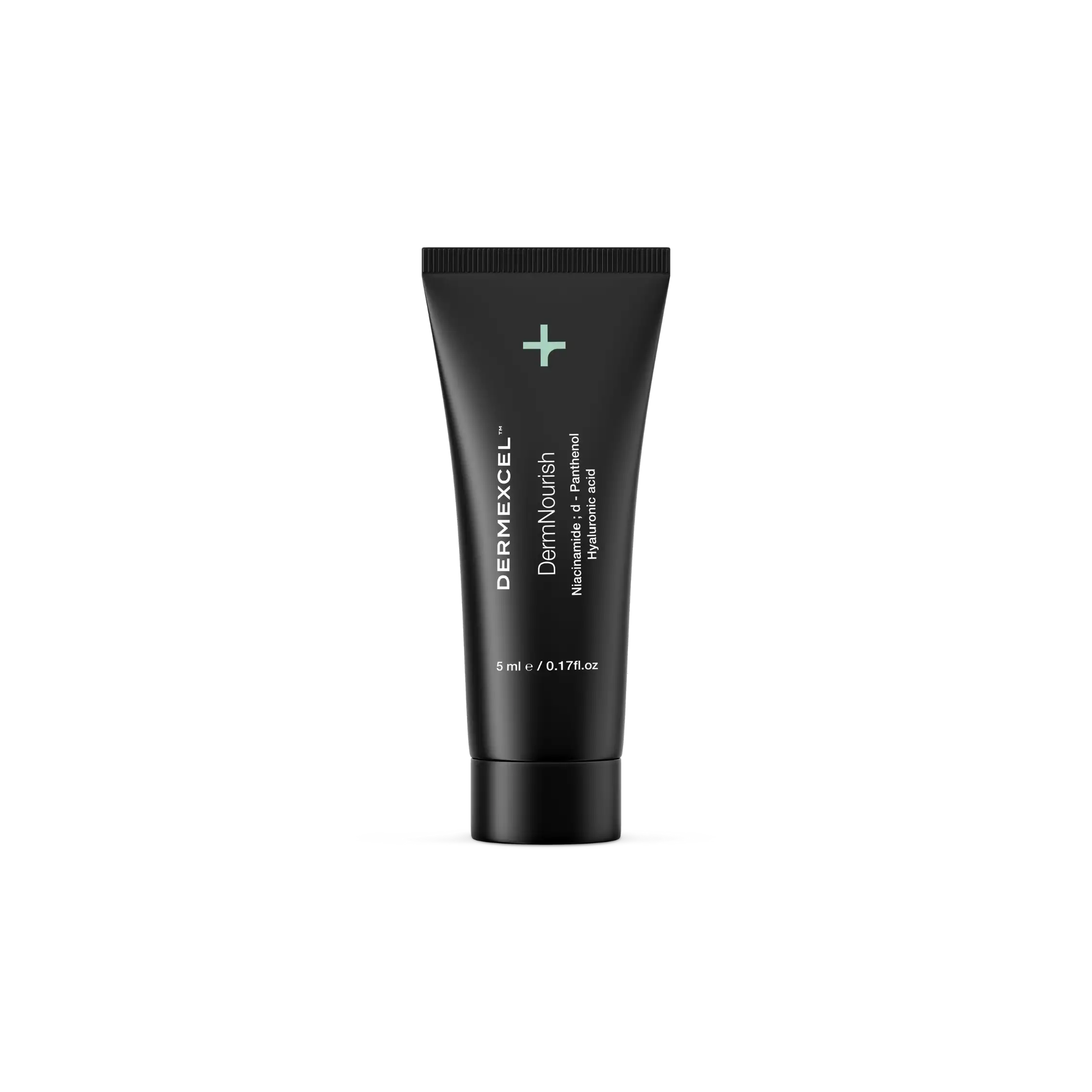
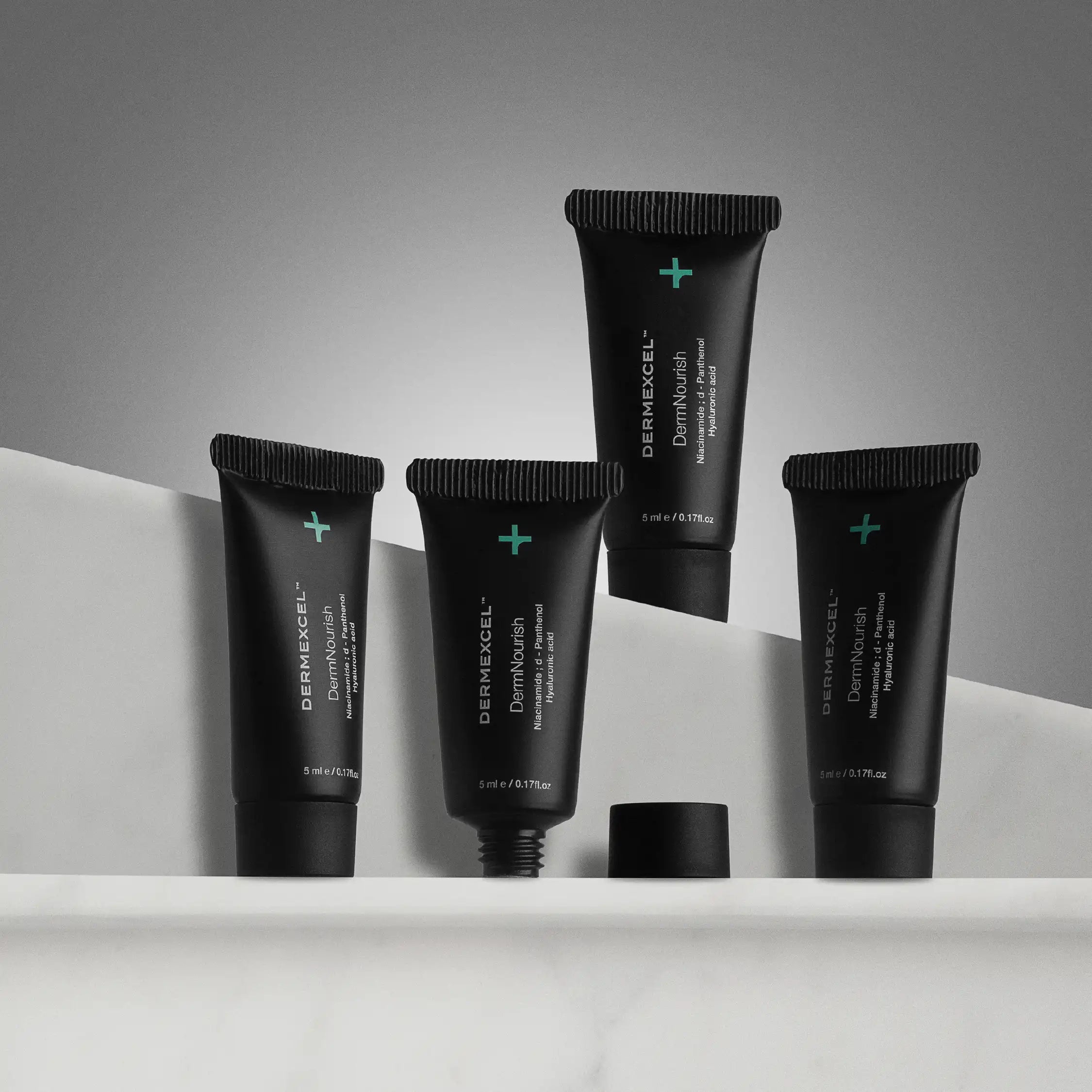
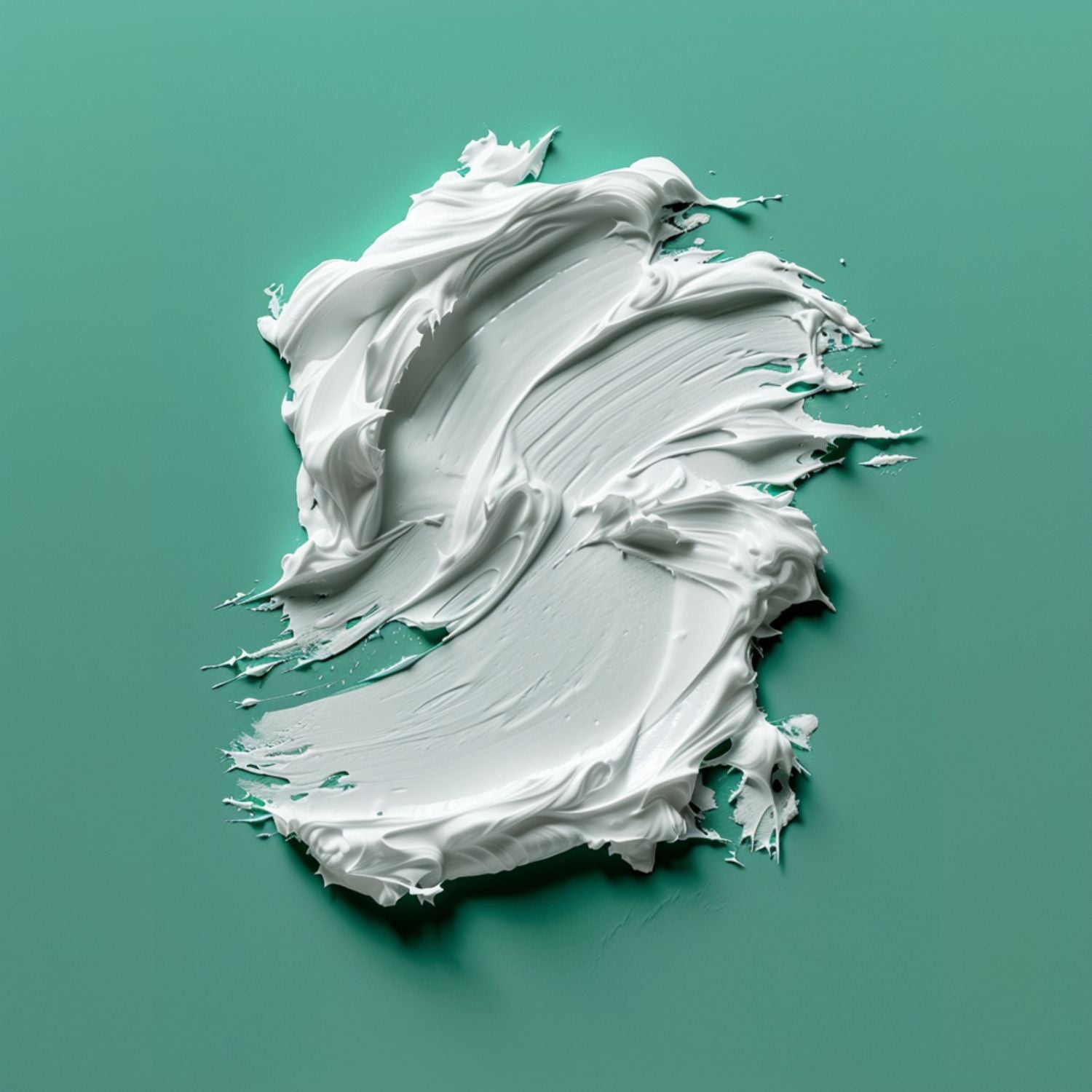
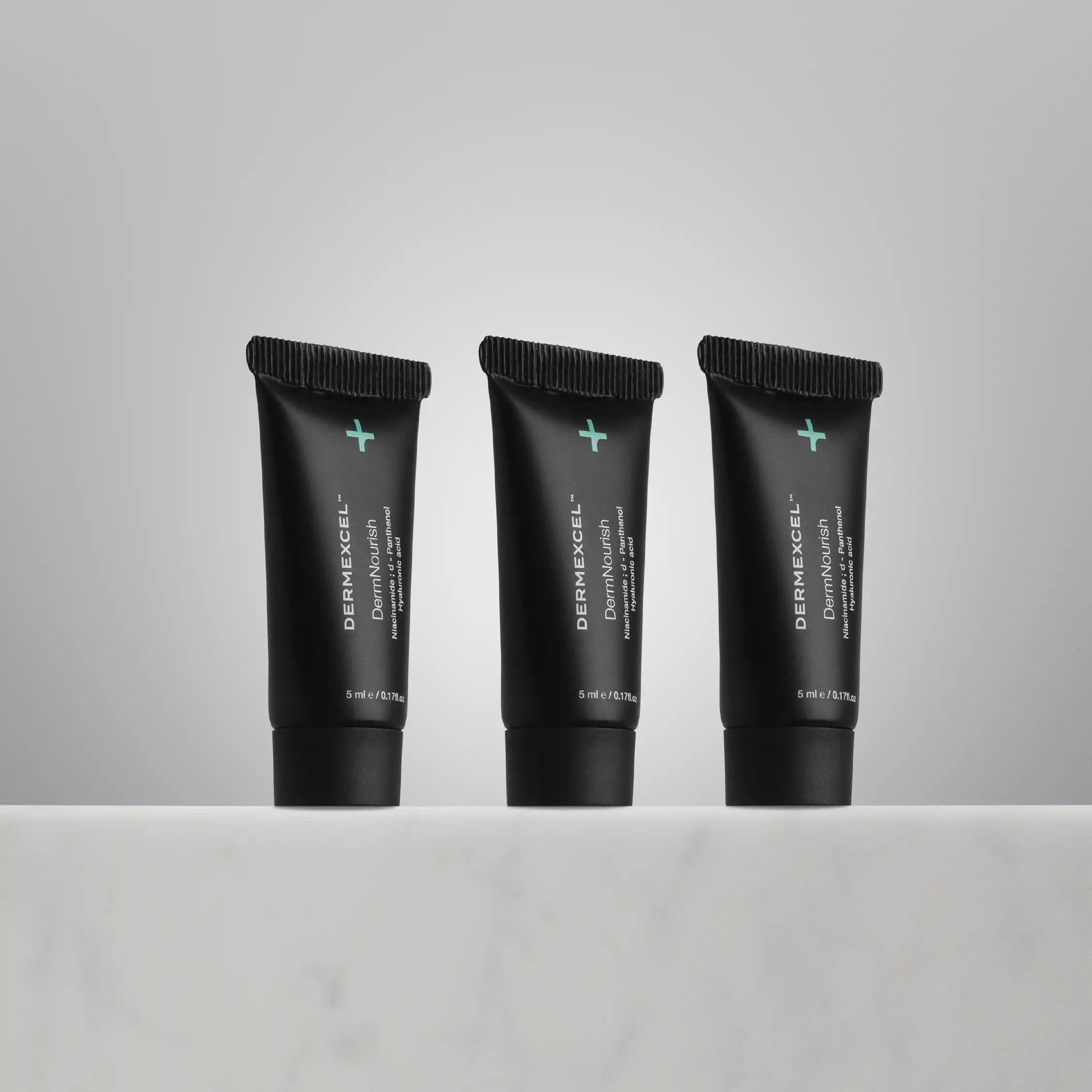
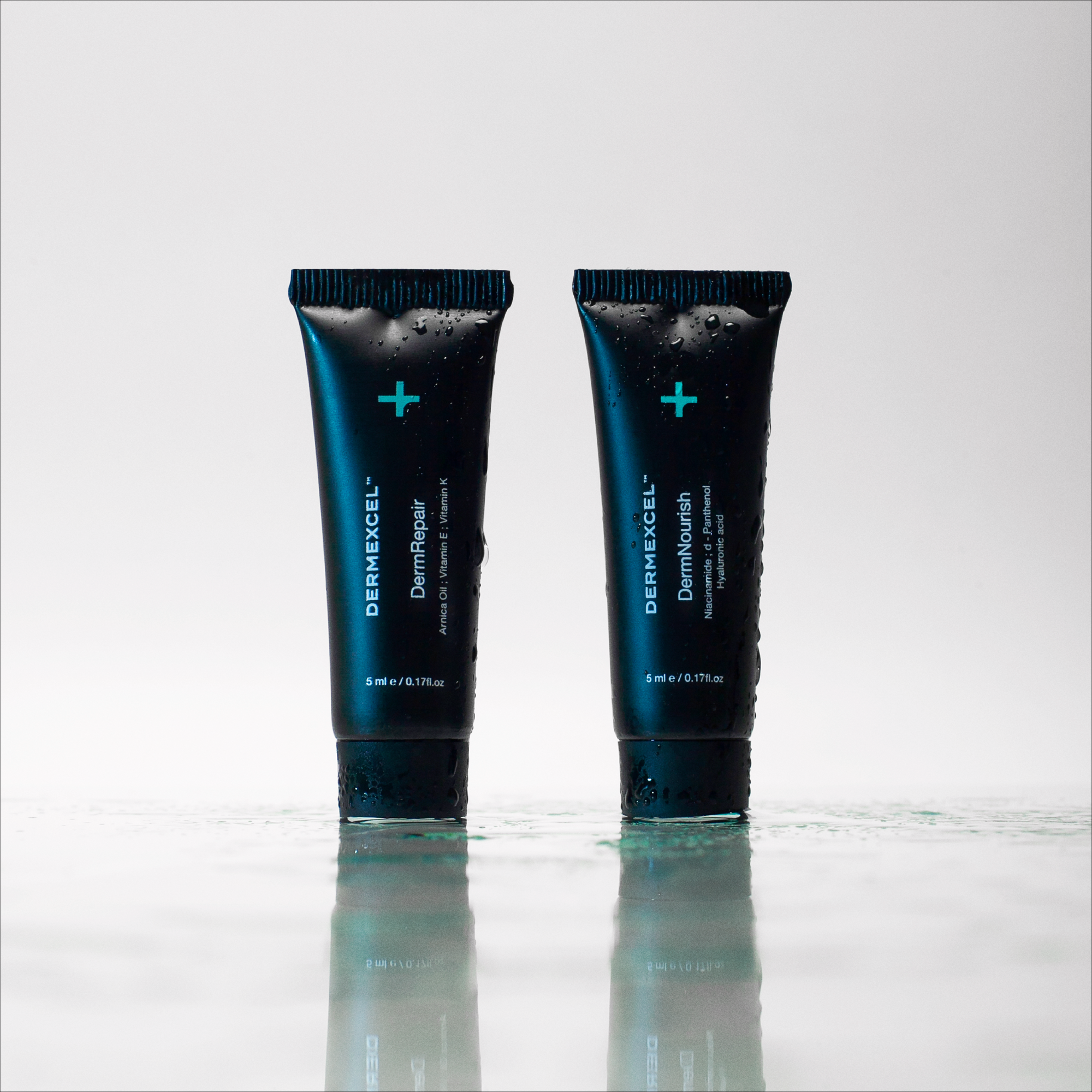




Age-Defence Moisturizer
Pay interest-free installments from R 20.25 with various payment gateways selected at checkout.
SIZE: 5 mL

barrier repair

↑ Elasticity

anti-aging

Moisturizing

↓ inflammation
DermNourish™, a meticulously crafted formula, aids in hydrating parched, sensitive, or impaired skin, replenishing much-needed moisture. It provides a robust shield, fortifying skin's barrier function and alleviating the discomfort of dry, distressed, and post-procedural skin.
Non-acnegenic, free from fragrances and colorants, DermNourish™ aims to minimize potential irritations and contact dermatitis. Key components include DuraQuench™ IQ SA and Niacinamide, both beneficial for skin's moisture retention and barrier fortification, and D-Panthenol, which soothes skin. Tocopherol, an antioxidant, protects against environmental stressors, while Sodium Hyaluronate bolsters skin hydration. DermNourish™ represents an advanced skin nourishment approach.
Hyaluronic acid
Hyaluronic acid (HA) is a naturally occurring glycosaminoglycan found throughout the body's connective, epithelial, and neural tissues. Most abundantly present in the skin, eyes, and synovial fluid, HA is renowned for its exceptional capacity to retain moisture — a single gram can hold up to six liters of water.
In skincare, the primary appeal of hyaluronic acid lies in its unparalleled hydrating abilities. As a humectant, HA attracts and retains moisture from the environment, providing intense hydration to the skin. This hydrating property contributes significantly to maintaining skin plumpness, suppleness, and elasticity.
Beyond hydration, hyaluronic acid also plays a vital role in skin repair and regeneration. It supports the skin's healing and repair processes, and its anti-inflammatory properties help calm irritated skin. Moreover, HA's ability to promote collagen production, a crucial protein for skin elasticity, further underscores its anti-aging benefits.
The molecular size of hyaluronic acid influences its skin penetration and efficacy. High-molecular-weight HA remains on the skin's surface, providing hydration and forming a barrier against moisture loss. In contrast, low-molecular-weight HA penetrates deeper into the skin's layers, offering more profound hydrating and rejuvenating effects.
Hyaluronic acid's remarkable ability to hydrate, improve skin elasticity, aid in wound healing, and provide antioxidant protection makes it valuable in managing various dermatological conditions, particularly aging, dryness, and sensitive skin.
Physiological Effects
- Hydration: Hyaluronic acid is a powerful humectant that can hold up to 1000 times its weight in water, significantly enhancing skin hydration and leading to plumper, more hydrated skin.
- Skin Elasticity and Wrinkle Reduction: By increasing skin moisture, it improves skin elasticity, reduces the appearance of fine lines and wrinkles, and gives the skin a more youthful appearance.
- Wound Healing: It plays a role in wound healing due to its ability to regulate inflammation levels and signal the body to build more blood vessels in the damaged area.
- Barrier Enhancement: Hyaluronic acid helps reinforce the skin's natural barriers, protecting against environmental factors and retaining moisture.
- Antioxidant Properties: It provides antioxidant defense against free-radical damage from the sun and pollution.
Managing Dermatological Conditions
- Aging Skin: Its ability to reduce wrinkles and improve skin elasticity makes it popular in anti-aging skincare products.
- Dry Skin: Hyaluronic acid is beneficial in treating dry skin conditions by providing intense hydration.
- Wound Care: Its role in wound healing is leveraged in post-procedure care, such as after laser treatments, and in healing minor cuts and abrasions.
- Acne Scars: It can help treat acne scars by promoting skin regeneration and reducing inflammation.
- Sensitive Skin: Hyaluronic acid is suitable for sensitive skin due to its gentle nature. It provides hydration without irritating.
References
- Papakonstantinou, E., Roth, M., & Karakiulakis, G. (2012). Hyaluronic acid: A key molecule in skin aging. Dermato-endocrinology.
- Jegasothy, S. M., Zabolotniaia, V., & Bielfeldt, S. (2014). Efficacy of a new topical nano-hyaluronic acid in humans. The Journal of Clinical and Aesthetic Dermatology.
- Wollina, U., & Abdel-Naser, M. B. (2019). Hyaluronic acid in the treatment and prevention of skin diseases: Molecular biological, pharmaceutical and clinical aspects. Skin Pharmacology and Physiology.
d-Panthenol
d-Panthenol's multifaceted effects on skin hydration, barrier strengthening, and wound healing make it a valuable component in the management of various dermatological conditions, from dry skin to post-procedure care.
d-Panthenol, also known as pro-vitamin B5, is a popular dermatological ingredient due to its beneficial effects on the skin. Here's a brief overview of its physiological effects and roles in managing various skin conditions:
Physiological Effects
- Hydration: d-Panthenol is a humectant, meaning it helps to attract and retain moisture in the skin. This leads to increased skin hydration, which can improve skin softness and elasticity.
- Wound Healing and Repair: It plays a role in the synthesis of lipids and proteins, essential for skin repair. d-Panthenol has been shown to accelerate re-epithelialization in wound healing.
- Anti-Inflammatory Effect: d-Panthenol can reduce inflammation, making it beneficial in treating skin irritations and erythema.
- Skin Barrier Strengthening: By enhancing the synthesis of lipids and proteins, d-Panthenol contributes to the strengthening of the skin's barrier function, protecting against irritants and environmental damage.
- Soothing and Softening: It soothes the skin and makes it feel softer and smoother, which can be particularly beneficial for dry or rough skin textures.
Managing Dermatological Conditions
- Minor Wounds and Skin Irritations: Due to its role in skin repair and anti-inflammatory properties, d-Panthenol is used in the treatment of minor wounds, cuts, and skin irritations.
- Dermatitis and Eczema: It helps in managing conditions like dermatitis and eczema by reducing inflammation and enhancing skin barrier function.
- Dry Skin Conditions (Xerosis): Its moisturizing properties make it effective in treating dry skin, providing relief from itching and scaling.
- Post-procedure Care: d-Panthenol is often used in post-procedure care, such as after laser treatments or chemical peels, to aid in skin recovery and reduce inflammation.
References
- Proksch, E., & Nissen, H. P. (2002). Dexpanthenol enhances skin barrier repair and reduces inflammation after sodium lauryl sulphate-induced irritation. Journal of Dermatological Treatment.
- Ebner, F., Heller, A., Rippke, F., & Tausch, I. (2002). Topical use of dexpanthenol in skin disorders. American Journal of Clinical Dermatology.
- Camargo, F. B. Jr, Gaspar, L. R., & Maia Campos, P. M. B. G. (2011). Skin moisturizing effects of panthenol-based formulations. Journal of Cosmetic Science.
Niacinamide
Niacinamide offers several benefits for the skin, primarily due to its anti-inflammatory and antioxidant properties. It reduces the redness and inflammation associated with acne, rosacea, and other inflammatory skin conditions. Additionally, niacinamide's ability to improve the skin's barrier function benefits all skin types, particularly those with eczema or mature skin.
Another significant benefit of niacinamide is its role in reducing hyperpigmentation. Studies have shown that it can decrease the transfer of melanin to the epidermis, helping to fade dark spots and even out skin tone.
Niacinamide also plays a role in reducing the visible signs of aging. It has been found to stimulate collagen production and improve skin elasticity, reducing fine lines and wrinkles. Its antioxidant properties further protect the skin from environmental damage, such as pollution and UV radiation, which contribute to premature aging.
The efficacy of niacinamide and its ability to address multiple skin concerns simultaneously has led to its growing popularity in both over-the-counter and prescription skincare formulations.
Physiological Effects
- Barrier Function Enhancement: Niacinamide helps strengthen the skin’s barrier function by increasing the production of ceramides, lipids that keep the skin hydrated and protect against environmental damage.
- Anti-inflammatory Properties: It has notable anti-inflammatory effects, which are beneficial in reducing redness and inflammation associated with acne, eczema, and other inflammatory skin conditions.
- Sebum Regulation: Niacinamide helps regulate sebum production, which controls excess oiliness and can benefit acne-prone skin.
- Hyperpigmentation Reduction: It reduces hyperpigmentation by inhibiting melanosome transfer from melanocytes to keratinocytes, leading to an even skin tone.
- Anti-aging Effects: Niacinamide helps reduce the appearance of fine lines and wrinkles by boosting collagen production and improving skin elasticity.
- Antioxidant Activity: It has antioxidant properties, protecting the skin from oxidative stress and environmental aggressors like UV radiation and pollution.
Managing Dermatological Conditions
- Acne and Oily Skin: Niacinamide effectively manages acne and oily skin by regulating sebum and reducing inflammation.
- Hyperpigmentation and Melasma: Its ability to reduce melanin transfer benefits it in treating hyperpigmentation and melasma.
- Aging Skin: Niacinamide targets wrinkles and loss of firmness.
- Skin Barrier Disorders: Niacinamide is beneficial in treating skin barrier disorders like atopic dermatitis and eczema by enhancing barrier function and hydration.
- Photodamage and Skin Protection: It helps mitigate the effects of photodamage and provides some degree of protection against environmental damage.
References
- Gehring, W. (2004). Nicotinic acid/niacinamide and the skin. Journal of Cosmetic Dermatology.
- Bissett, D. L., Oblong, J. E., & Berge, C. A. (2005). Niacinamide: A B vitamin that improves aging facial skin appearance. Dermatologic Surgery.
- Snaidr, V. A., Damian, D. L., & Halliday, G. M. (2019). Nicotinamide for photoprotection and skin cancer chemoprevention: A review of efficacy and safety. Experimental Dermatology.
- Navarrete-Solís, J. et al. (2011). A Double-Blind, Randomized Clinical Trial of Niacinamide 4% versus Hydroquinone 4% in the Treatment of Melasma. Dermatology Research and Practice, 2011.
Emollients
Emollients are crucial in dermatological care, primarily because they enhance skin hydration and barrier function. Here's a brief overview of their physiological effects and roles in managing various skin conditions.
Physiological Effects
- Hydration of Stratum Corneum: Emollients increase moisture content in the stratum corneum, the outermost layer of the skin, by reducing transepidermal water loss (TEWL). This is achieved through occlusion, which traps water in the skin.
- Restoration of Skin Barrier Function: They aid in replenishing the skin's lipid barrier, which is essential for maintaining skin integrity and protective function.
- Soothing and Smoothing Effects: Emollients smooth, flaky skin cells, making the skin surface appear smoother. They also provide a soothing effect, which can reduce itching and discomfort.
- Anti-inflammatory Properties: Some emollients have ingredients that offer mild anti-inflammatory benefits, helping to reduce redness and irritation.
Managing Dermatological Conditions
- Atopic Dermatitis (Eczema): Emollients are a cornerstone in the management of eczema, helping to maintain skin hydration, reduce flare-ups, and minimize the need for topical corticosteroids.
- Psoriasis: Regular use of emollients can reduce scaling and dryness associated with psoriasis, improving the efficacy of other topical treatments.
- Ichthyosis and Xerosis: These conditions, characterized by dry, scaly skin, benefit significantly from emollients, which help hydrate and soften the skin.
- Aging Skin: Emollients improve the appearance of aging skin by hydrating and reducing the visibility of fine lines and wrinkles.
- Skin Protection: Emollients can protect the skin from irritation and breakdown in individuals with incontinence or those who are bedridden.
References
- Proksch, E., & Lachapelle, J. M. (2005). The Management of Dry Skin with Topical Emollients. American Journal of Clinical Dermatology.
- Lynde, C. W. (2001). Moisturizers: What They Are and a Practical Approach to Product Selection. Skin Therapy Letter.
- Lodén, M. (2003). Role of Topical Emollients and Moisturizers in the Treatment of Dry Skin Barrier Disorders. American Journal of Clinical Dermatology.
Lipid Bilayer Technology
Lipid bilayer technology in dermatology focuses on mimicking and reinforcing the skin's natural lipid barrier, which is vital for maintaining skin health and integrity.
Physiological Effects
- Reinforcement of Skin Barrier: Lipid bilayer technology aims to replicate the skin's natural barrier, particularly beneficial for damaged or compromised skin. This reinforcement helps in reducing transepidermal water loss (TEWL) and enhancing skin hydration.
- Restoration of Lipid Composition: It helps in replenishing the essential lipids that are often deficient in certain skin conditions, thereby restoring the skin's natural protective barrier.
- Improvement in Skin Texture and Hydration: By restoring the lipid bilayer, this technology improves skin texture and overall hydration, leading to healthier, more resilient skin.
- Reduction of Inflammation and Irritation: It can help in reducing inflammation and irritation, particularly in conditions where the skin barrier is compromised.
Managing Dermatological Conditions
- Atopic Dermatitis (Eczema): Lipid bilayer technology is particularly beneficial in managing eczema, as it helps in restoring the deficient skin barrier function, reducing dryness, and controlling flare-ups.
- Psoriasis: In psoriasis, where the skin barrier is also disrupted, this technology aids in hydrating the skin and reducing scaling.
- Aging Skin: The aging skin, which naturally loses lipids over time, benefits from lipid bilayer technology as it helps in maintaining skin hydration and elasticity.
- Dry Skin Conditions (Xerosis, Ichthyosis): Enhancing the skin’s lipid content can significantly improve symptoms of dryness and scaling in these conditions.
- Sensitive Skin: For sensitive skin types, lipid bilayer technology can provide a gentle and effective way to strengthen the skin barrier without causing irritation.
References
- Del Rosso, J. Q., & Levin, J. (2011). The Clinical Relevance of Maintaining the Functional Integrity of the Stratum Corneum in both Healthy and Disease-affected Skin. Journal of Clinical and Aesthetic Dermatology.
- Rawlings, A. V., & Harding, C. R. (2004). Moisturization and Skin Barrier Function. Dermatologic Therapy.
- Man, M. Q., Xin, S. J., Song, S. P., Cho, S. Y., Zhang, X. J., Tu, C. X., ... & Elias, P. M. (2009). Variation of Skin Surface pH, Sebum Content and Stratum Corneum Hydration with Age and Gender in a Large Chinese Population. Skin Pharmacology and Physiology.




SHIPPING
- Shipping Guarantee: Guiding you to healthy skin isn’t only about our products; it's also about getting them to you as swiftly as the science behind them. That's why Dermal Health offers a shipping guarantee you can rely on.
- Where We Ship From: Orders are dispatched from our facilities in Pretoria.
- Who We Ship With: We trust only well-known, popular, and dependable courier services with your packages.
- When You'll Get It: Expect confident skin soon! Shipping addresses in Pretoria and Johannesburg will enjoy delivery from same-day to 2 business days. Shipping addresses further from Pretoria may expect delivery within 1-4 business days, depending on the service you select during checkout. Your estimated delivery date will reflect during checkout so that you can mark your calendar.
- Tracking Your Order: Eager to start your DermExcel journey? We don't blame you! You'll receive a tracking number after you place your order so that you can follow your package.
For any shipping inquiries, our customer service team is ready to assist.
SECURE PAYMENT
Dermal Health Science 30-Day Confidence Guarantee: We are passionate about guiding you to healthy skin through medical science. We believe in the quality and effectiveness of our products so much that we offer a 30-Day Confidence Guarantee.
If you're unsatisfied with your purchase, simply return it within 30 days for a full refund.
Healthy Skin Is Not Complicated and neither is our return policy. Please visit our detailed return policy or contact our friendly customer service team for more information.
Feel as confident in us as we want you to feel in your skin.

Choose options
- Dry skin: A moisture-rich formula that replenishes hydration, alleviating dryness and discomfort.
- Sensitive skin: The absence of fragrances and colorants in the formulation makes DermNourish™ suitable for sensitive skin types, minimizing potential irritations.
- Compromised skin: Enhance the skin’s barrier function and provide the necessary care.
- Itching: Relieves itching, particularly in dry or distressed skin.
- Post-procedure skin care: DermNourish™ supports skin recovery after dermatological procedures, helping to nourish and comfort the skin.
- Skin exposed to environmental stressors: DermNourish™ contains antioxidants that protect the skin from environmental damage.
- Application time: Morning and/or Evening.
- Frequency: Use once or twice daily, depending on the severity of skin dryness or sensitivity, or use according to your dermal Diagnosis treatment instructions.
- Start with clean and dry skin.
- Use your DermExcel cleanser to remove dirt and excess oil from your skin.
- Dispense moisturizer onto your fingertips. Smooth the product evenly over your face. Ensure you cover all dry or sensitive areas.
- Using your fingertips, gently massage the product into your skin in a circular motion until fully absorbed.
- Apply your moisturizer to damp skin. Moisturizers are most effective if you use them while your skin is damp because damp skin absorbs the product more readily. That also gives the moisturizer a chance to lock in that hydration.
Active ingredients
- Hydration: Hyaluronic acid is a powerful humectant that can hold up to 1000 times its weight in water, significantly enhancing skin hydration and leading to plumper, more hydrated skin.
- Skin Elasticity and Wrinkle Reduction: By increasing skin moisture, it improves skin elasticity, reduces the appearance of fine lines and wrinkles, and gives the skin a more youthful appearance.
- Wound Healing: It plays a role in wound healing due to its ability to regulate inflammation levels and signal the body to build more blood vessels in the damaged area.
- Barrier Enhancement: Hyaluronic acid helps reinforce the skin's natural barriers, protecting against environmental factors and retaining moisture.
- Antioxidant Properties: It provides antioxidant defense against free-radical damage from the sun and pollution.
- Aging Skin: Its ability to reduce wrinkles and improve skin elasticity makes it popular in anti-aging skincare products.
- Dry Skin: Hyaluronic acid is beneficial in treating dry skin conditions by providing intense hydration.
- Wound Care: Its role in wound healing is leveraged in post-procedure care, such as after laser treatments, and in healing minor cuts and abrasions.
- Acne Scars: It can help treat acne scars by promoting skin regeneration and reducing inflammation.
- Sensitive Skin: Hyaluronic acid is suitable for sensitive skin due to its gentle nature. It provides hydration without irritating.
- Papakonstantinou, E., Roth, M., & Karakiulakis, G. (2012). Hyaluronic acid: A key molecule in skin aging. Dermato-endocrinology.
- Jegasothy, S. M., Zabolotniaia, V., & Bielfeldt, S. (2014). Efficacy of a new topical nano-hyaluronic acid in humans. The Journal of Clinical and Aesthetic Dermatology.
- Wollina, U., & Abdel-Naser, M. B. (2019). Hyaluronic acid in the treatment and prevention of skin diseases: Molecular biological, pharmaceutical and clinical aspects. Skin Pharmacology and Physiology.
- Hydration: d-Panthenol is a humectant, meaning it helps to attract and retain moisture in the skin. This leads to increased skin hydration, which can improve skin softness and elasticity.
- Wound Healing and Repair: It plays a role in the synthesis of lipids and proteins, essential for skin repair. d-Panthenol has been shown to accelerate re-epithelialization in wound healing.
- Anti-Inflammatory Effect: d-Panthenol can reduce inflammation, making it beneficial in treating skin irritations and erythema.
- Skin Barrier Strengthening: By enhancing the synthesis of lipids and proteins, d-Panthenol contributes to the strengthening of the skin's barrier function, protecting against irritants and environmental damage.
- Soothing and Softening: It soothes the skin and makes it feel softer and smoother, which can be particularly beneficial for dry or rough skin textures.
- Minor Wounds and Skin Irritations: Due to its role in skin repair and anti-inflammatory properties, d-Panthenol is used in the treatment of minor wounds, cuts, and skin irritations.
- Dermatitis and Eczema: It helps in managing conditions like dermatitis and eczema by reducing inflammation and enhancing skin barrier function.
- Dry Skin Conditions (Xerosis): Its moisturizing properties make it effective in treating dry skin, providing relief from itching and scaling.
- Post-procedure Care: d-Panthenol is often used in post-procedure care, such as after laser treatments or chemical peels, to aid in skin recovery and reduce inflammation.
- Proksch, E., & Nissen, H. P. (2002). Dexpanthenol enhances skin barrier repair and reduces inflammation after sodium lauryl sulphate-induced irritation. Journal of Dermatological Treatment.
- Ebner, F., Heller, A., Rippke, F., & Tausch, I. (2002). Topical use of dexpanthenol in skin disorders. American Journal of Clinical Dermatology.
- Camargo, F. B. Jr, Gaspar, L. R., & Maia Campos, P. M. B. G. (2011). Skin moisturizing effects of panthenol-based formulations. Journal of Cosmetic Science.
- Barrier Function Enhancement: Niacinamide helps strengthen the skin’s barrier function by increasing the production of ceramides, lipids that keep the skin hydrated and protect against environmental damage.
- Anti-inflammatory Properties: It has notable anti-inflammatory effects, which are beneficial in reducing redness and inflammation associated with acne, eczema, and other inflammatory skin conditions.
- Sebum Regulation: Niacinamide helps regulate sebum production, which controls excess oiliness and can benefit acne-prone skin.
- Hyperpigmentation Reduction: It reduces hyperpigmentation by inhibiting melanosome transfer from melanocytes to keratinocytes, leading to an even skin tone.
- Anti-aging Effects: Niacinamide helps reduce the appearance of fine lines and wrinkles by boosting collagen production and improving skin elasticity.
- Antioxidant Activity: It has antioxidant properties, protecting the skin from oxidative stress and environmental aggressors like UV radiation and pollution.
- Acne and Oily Skin: Niacinamide effectively manages acne and oily skin by regulating sebum and reducing inflammation.
- Hyperpigmentation and Melasma: Its ability to reduce melanin transfer benefits it in treating hyperpigmentation and melasma.
- Aging Skin: Niacinamide targets wrinkles and loss of firmness.
- Skin Barrier Disorders: Niacinamide is beneficial in treating skin barrier disorders like atopic dermatitis and eczema by enhancing barrier function and hydration.
- Photodamage and Skin Protection: It helps mitigate the effects of photodamage and provides some degree of protection against environmental damage.
- Gehring, W. (2004). Nicotinic acid/niacinamide and the skin. Journal of Cosmetic Dermatology.
- Bissett, D. L., Oblong, J. E., & Berge, C. A. (2005). Niacinamide: A B vitamin that improves aging facial skin appearance. Dermatologic Surgery.
- Snaidr, V. A., Damian, D. L., & Halliday, G. M. (2019). Nicotinamide for photoprotection and skin cancer chemoprevention: A review of efficacy and safety. Experimental Dermatology.
- Navarrete-Solís, J. et al. (2011). A Double-Blind, Randomized Clinical Trial of Niacinamide 4% versus Hydroquinone 4% in the Treatment of Melasma. Dermatology Research and Practice, 2011.
- Hydration of Stratum Corneum: Emollients increase moisture content in the stratum corneum, the outermost layer of the skin, by reducing transepidermal water loss (TEWL). This is achieved through occlusion, which traps water in the skin.
- Restoration of Skin Barrier Function: They aid in replenishing the skin's lipid barrier, which is essential for maintaining skin integrity and protective function.
- Soothing and Smoothing Effects: Emollients smooth, flaky skin cells, making the skin surface appear smoother. They also provide a soothing effect, which can reduce itching and discomfort.
- Anti-inflammatory Properties: Some emollients have ingredients that offer mild anti-inflammatory benefits, helping to reduce redness and irritation.
- Atopic Dermatitis (Eczema): Emollients are a cornerstone in the management of eczema, helping to maintain skin hydration, reduce flare-ups, and minimize the need for topical corticosteroids.
- Psoriasis: Regular use of emollients can reduce scaling and dryness associated with psoriasis, improving the efficacy of other topical treatments.
- Ichthyosis and Xerosis: These conditions, characterized by dry, scaly skin, benefit significantly from emollients, which help hydrate and soften the skin.
- Aging Skin: Emollients improve the appearance of aging skin by hydrating and reducing the visibility of fine lines and wrinkles.
- Skin Protection: Emollients can protect the skin from irritation and breakdown in individuals with incontinence or those who are bedridden.
- Proksch, E., & Lachapelle, J. M. (2005). The Management of Dry Skin with Topical Emollients. American Journal of Clinical Dermatology.
- Lynde, C. W. (2001). Moisturizers: What They Are and a Practical Approach to Product Selection. Skin Therapy Letter.
- Lodén, M. (2003). Role of Topical Emollients and Moisturizers in the Treatment of Dry Skin Barrier Disorders. American Journal of Clinical Dermatology.
- Reinforcement of Skin Barrier: Lipid bilayer technology aims to replicate the skin's natural barrier, particularly beneficial for damaged or compromised skin. This reinforcement helps in reducing transepidermal water loss (TEWL) and enhancing skin hydration.
- Restoration of Lipid Composition: It helps in replenishing the essential lipids that are often deficient in certain skin conditions, thereby restoring the skin's natural protective barrier.
- Improvement in Skin Texture and Hydration: By restoring the lipid bilayer, this technology improves skin texture and overall hydration, leading to healthier, more resilient skin.
- Reduction of Inflammation and Irritation: It can help in reducing inflammation and irritation, particularly in conditions where the skin barrier is compromised.
- Atopic Dermatitis (Eczema): Lipid bilayer technology is particularly beneficial in managing eczema, as it helps in restoring the deficient skin barrier function, reducing dryness, and controlling flare-ups.
- Psoriasis: In psoriasis, where the skin barrier is also disrupted, this technology aids in hydrating the skin and reducing scaling.
- Aging Skin: The aging skin, which naturally loses lipids over time, benefits from lipid bilayer technology as it helps in maintaining skin hydration and elasticity.
- Dry Skin Conditions (Xerosis, Ichthyosis): Enhancing the skin’s lipid content can significantly improve symptoms of dryness and scaling in these conditions.
- Sensitive Skin: For sensitive skin types, lipid bilayer technology can provide a gentle and effective way to strengthen the skin barrier without causing irritation.
- Del Rosso, J. Q., & Levin, J. (2011). The Clinical Relevance of Maintaining the Functional Integrity of the Stratum Corneum in both Healthy and Disease-affected Skin. Journal of Clinical and Aesthetic Dermatology.
- Rawlings, A. V., & Harding, C. R. (2004). Moisturization and Skin Barrier Function. Dermatologic Therapy.
- Man, M. Q., Xin, S. J., Song, S. P., Cho, S. Y., Zhang, X. J., Tu, C. X., ... & Elias, P. M. (2009). Variation of Skin Surface pH, Sebum Content and Stratum Corneum Hydration with Age and Gender in a Large Chinese Population. Skin Pharmacology and Physiology.
Hyaluronic acid
Hyaluronic acid (HA) is a naturally occurring glycosaminoglycan found throughout the body's connective, epithelial, and neural tissues. Most abundantly present in the skin, eyes, and synovial fluid, HA is renowned for its exceptional capacity to retain moisture — a single gram can hold up to six liters of water.
In skincare, the primary appeal of hyaluronic acid lies in its unparalleled hydrating abilities. As a humectant, HA attracts and retains moisture from the environment, providing intense hydration to the skin. This hydrating property contributes significantly to maintaining skin plumpness, suppleness, and elasticity.
Beyond hydration, hyaluronic acid also plays a vital role in skin repair and regeneration. It supports the skin's healing and repair processes, and its anti-inflammatory properties help calm irritated skin. Moreover, HA's ability to promote collagen production, a crucial protein for skin elasticity, further underscores its anti-aging benefits.
The molecular size of hyaluronic acid influences its skin penetration and efficacy. High-molecular-weight HA remains on the skin's surface, providing hydration and forming a barrier against moisture loss. In contrast, low-molecular-weight HA penetrates deeper into the skin's layers, offering more profound hydrating and rejuvenating effects.
Hyaluronic acid's remarkable ability to hydrate, improve skin elasticity, aid in wound healing, and provide antioxidant protection makes it valuable in managing various dermatological conditions, particularly aging, dryness, and sensitive skin.
Physiological Effects
Managing Dermatological Conditions
References
d-Panthenol
d-Panthenol's multifaceted effects on skin hydration, barrier strengthening, and wound healing make it a valuable component in the management of various dermatological conditions, from dry skin to post-procedure care.
d-Panthenol, also known as pro-vitamin B5, is a popular dermatological ingredient due to its beneficial effects on the skin. Here's a brief overview of its physiological effects and roles in managing various skin conditions:
Physiological Effects
Managing Dermatological Conditions
References
Niacinamide
Niacinamide offers several benefits for the skin, primarily due to its anti-inflammatory and antioxidant properties. It reduces the redness and inflammation associated with acne, rosacea, and other inflammatory skin conditions. Additionally, niacinamide's ability to improve the skin's barrier function benefits all skin types, particularly those with eczema or mature skin.
Another significant benefit of niacinamide is its role in reducing hyperpigmentation. Studies have shown that it can decrease the transfer of melanin to the epidermis, helping to fade dark spots and even out skin tone.
Niacinamide also plays a role in reducing the visible signs of aging. It has been found to stimulate collagen production and improve skin elasticity, reducing fine lines and wrinkles. Its antioxidant properties further protect the skin from environmental damage, such as pollution and UV radiation, which contribute to premature aging.
The efficacy of niacinamide and its ability to address multiple skin concerns simultaneously has led to its growing popularity in both over-the-counter and prescription skincare formulations.
Physiological Effects
Managing Dermatological Conditions
References
Emollients
Emollients are crucial in dermatological care, primarily because they enhance skin hydration and barrier function. Here's a brief overview of their physiological effects and roles in managing various skin conditions.
Physiological Effects
Managing Dermatological Conditions
References
Lipid Bilayer Technology
Lipid bilayer technology in dermatology focuses on mimicking and reinforcing the skin's natural lipid barrier, which is vital for maintaining skin health and integrity.
Physiological Effects
Managing Dermatological Conditions
References
Full Ingredient list
Aqua, Glycerin, Cetearyl Alcohol & Polysorbate 60, Petrolatum, Cetyl Stearate & Isostearyl Isostearate & Cetyl Alcohol & Potassium Cetyl Phosphate & Stearic Acid, Light Paraffinum Liquidum, Cyclopentasiloxane & C30-45 Alkyl Cetearyl Dimethicone Crosspolymer & PEG/PPG-20/23 Dimethicone, Niacinamide, Tocopherol, d-Panthenol, Sodium Hyaluronate
DermNourish: Travel Size
product benefits

Protective barrier
Shield the skin from external irritants and pollutants by forming a protective barrier, providing continuous hydration, improving skin elasticity, and supporting the skin's natural defense mechanisms.

Sun-damaged skin repair
Replenish and rejuvenate sun-damaged skin, promoting the skin's natural healing process and reducing the impact of sun damage.

Anti-Aging
Supports skin cell renewal and helps improve the appearance of aging skin by revitalizing and repairing action.

soothe inflamed skin
It soothes inflammation by calming the skin's immune response, reducing redness and swelling associated with irritation.
Indications for DermNourish: Travel Size
Aging Skin
Dull & Lifeless Skin
Flaking skin
Sensitive Skin
Rough Skin Texture
dermnourish
mode of action
Moisturizing
LIPID-BILAYER BARRIER REPAIR TECHNOLOGY
- DermNourish™ supports the skin's natural lipid bilayer by replenishing essential lipids that maintain the barrier's structure and function. This helps to restore moisture retention, enhance the skin's defense mechanisms, and protect against environmental stressors. By reinforcing the lipid bilayer, the product improves overall barrier function, promoting healthier and more resilient skin.
______
EMOLLIENTS
- Emollients in the formulation smooth and soften the skin by filling gaps between skin cells caused by dryness or damage. This reduces roughness, improves skin texture, and enhances flexibility, leaving the skin feeling comfortable and nourished.
______
HUMECTANTS
- Humectants draw moisture into the skin, hydrating its uppermost layers. This increases skin suppleness, reduces dryness, and supports the natural repair processes by ensuring adequate hydration is maintained.
______
OCCLUSIVES
- Occlusives form a protective layer on the skin's surface, preventing moisture loss and locking in hydration provided by the humectants and emollients. This barrier also shields the skin from external irritants, pollutants, and environmental factors, ensuring long-lasting hydration and protection.
Anti-inflammatory
NIACINAMIDE
- Reduce the inflammatory response by inhibiting inflammatory messengers.
- Provides long-lasting protection against bacteria through activation of anti-microbial peptides
______
DPANTHENOL
Soothes and reduces inflammation:
- Panthenol’s moisturizing properties also contribute to its anti-inflammatory nature.
- Keeping the skin moisturized can help prevent it from becoming sensitive and easily irritated. As such, panthenol can help improve the roughness, dryness, itching, redness, and scaling associated with conditions such as eczema, contact dermatitis, and psoriasis.
- A 2019 study adds that panthenol may alleviate facial redness resulting from winter xerosis in people with sensitive skin.
Promotes wound healing:
- D-Panthenol is used in medical wound-healing formulations to help treat skin injuries, burns, and sunburn.
- D-Panthenol is also beneficial after medical and cosmetic surgeries for its wound-healing properties.
- It treats superficial and deep wounds by increasing cell turnover and fibroblast proliferation.
- A 2020 review on the role of d-panthenol on wound healing states that it is excellent for post-procedural wounds, especially when used immediately after skin damage.
Barrier Repair
NIACINAMIDE
- Niacinamide increases barrier layer proteins such as involucrin, filaggrin, and keratin. Filaggrin is critical in the formation of natural skin moisturizing factors.
- It stimulates the synthesis of ceramides and other intercellular lipids, decreasing trans-epidermal water loss (TEWL) and strengthening the skin's barrier against irritants and allergens.
- Aquaporin 3 is a gene that encodes water-permeable channels. The upregulation of aquaporin 3 is associated with Atopic Dermatitis / Eczema (AD), which leads to water loss through the skin. Niacinamide prevents the upregulation of aquaporin 3, thereby decreasing water permeability and water loss.
- Eczema/Atopic Dermatitis (AD) is an inflammatory skin condition. Niacinamide has anti-inflammatory properties by inhibiting PARP-1 and the associated expression of inflammatory cytokines, chemokines, adhesion molecules and inflammatory mediators.
- Increased cyclic adenosine monophosphate (cAMP) phosphodiesterase (PDE) contributes to increased histamine and IgE levels in Atopic Dermatitis.
- Increases production of ceramides as well as other stratum corneum lipids to improve skin barrier function.
______
D-PANTHENOL
- Panthenol promotes skin barrier repair by enhancing lipid synthesis and epidermal differentiation. This helps hydrate the outermost layer of the skin and locks in moisture.
- A 2016 study also found that d-panthenol increases the mobility of proteins and lipids in dehydrated skin, improving its elasticity and hydration. It also retains or increases molecular fluidity to compensate for reduced hydration.
- D-Panthenol is part of medical wound-healing formulations for its ability to help treat skin injuries, burns, and sunburn.
- D-Panthenol is also beneficial after medical and cosmetic surgeries for its wound-healing properties.
- It treats superficial and deep wounds by increasing cell turnover and fibroblast proliferation.
- A 2020 review on the role of d-panthenol on wound healing states that it is excellent for post-procedural wounds, especially when used immediately after skin damage.
Anti-aging
HYALURONIC ACID
- Hyaluronic acid increases pro-collagen I synthesis and reduces skin roughness.
- Hyaluronic acid plays an important role in skin aging. As cells age, they lose their ability to produce Hyaluronic acid. The skin becomes drier, thinner, and looser, leading to wrinkling, among other significant changes.
- Skin aging is also associated with a decrease in skin moisture. Hyaluronic acid has a unique capacity to link and retain water molecules. Hyaluronic acid is a natural component that is present in the whole body. It is naturally and constantly renewed because of its rapid degradation, but its renewal tends to slow with age and external aggressions. Therefore it is necessary to act very early, sustaining an optimal hyaluronic acid turnover, similar to that of young skin, in order to prevent the signs of aging.
- In relation to its biological effects at the skin level, it is known that hyaluronic acid is actively involved in skin cell signalling (by binding the CD44 and LYVE-1 receptors) and thus influences the extracellular matrix (ECM) stability.
- Hyaluronic acid has an impact on the growth of keratinocytes (skin cells) which protect the epidermis from aging and promotes elasticity.
______
NIACINAMIDE
- Stimulate collagen synthesis and significantly increase skin elasticity.
- Prevents the breakdown of collagen and elastin through antioxidant and anti-inflammatory activity.
- Prevents DNA damage through antioxidant activity.
- Increases production of ceramides as well as other stratum corneum lipids to improve skin barrier funtion.
- Niacinamide boosts cellular energy and may enhance energy-dependent cellular processes such as DNA repair.
treatment classes
moisturizing & barrier repair

- Emollients soften and smooth the skin. They fill the gaps between skin cells and replenish missing lipids, crucial for maintaining the skin's barrier function. This flattens the curled edges of individual skin cells (corneocytes), resulting in a smoother surface with enhanced light reflection.
- It improves skin texture, alleviates dryness and irritation, and promotes overall health and comfort.

- Humectants have high water absorption capabilities and draw moisture from the air into the skin, and from the dermis to the epidermis.
- By attracting and retaining moisture, humectants help maintain skin hydration, making it feel soft and supple.
- They help reduce lines and wrinkles by plumping up the skin, giving it a more youthful and radiant appearance.

- Occlusives create a protective layer on top of the skin that locks in moisture, prevents transepidermal water loss (TEWL), and protects the skin from external irritants such as pollutants, allergens, and harsh weather conditions, contributing to skin sensitivity and damage.
- For dry, cracked, or irritated skin, occlusives provide immediate relief by covering the affected area and preventing further moisture loss, allowing the skin to heal more effectively.

- This technology amplifies lipid production and replenishes the lamellar bilayers critical for normal barrier function and antimicrobial defense.
- It forms a double structural layer on the skin's surface to regenerate its natural barrier. Components are quickly absorbed into the underlying nucleated cell layers, which are then incorporated into lamellar bodies.
- This barrier repair therapy reduces inflammation through several mechanisms, leading to a smoother surface with less friction and greater light refraction.
Testimonials
DermNourish
I'm very grateful I came across your products and have been using it religiously for at least 3 years now. Only have a tiny issue - and that's with the Dermatint pump, the first/ original container worked much better ;)
Absolutely love it, amazing product!
DermNourish
DermNourish
Great moisturizer









